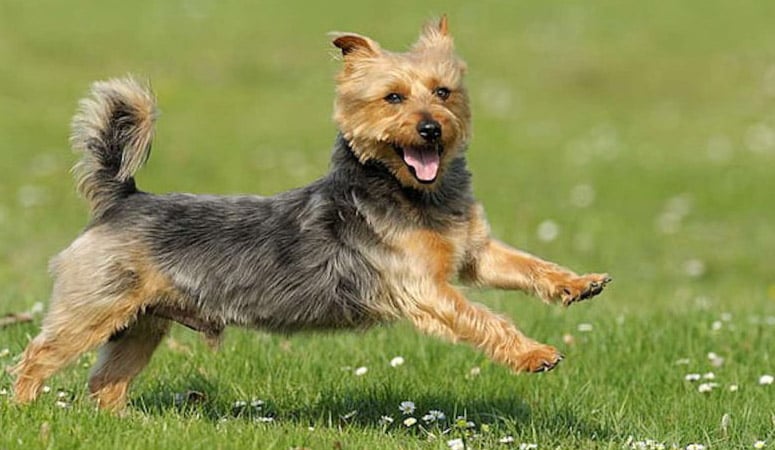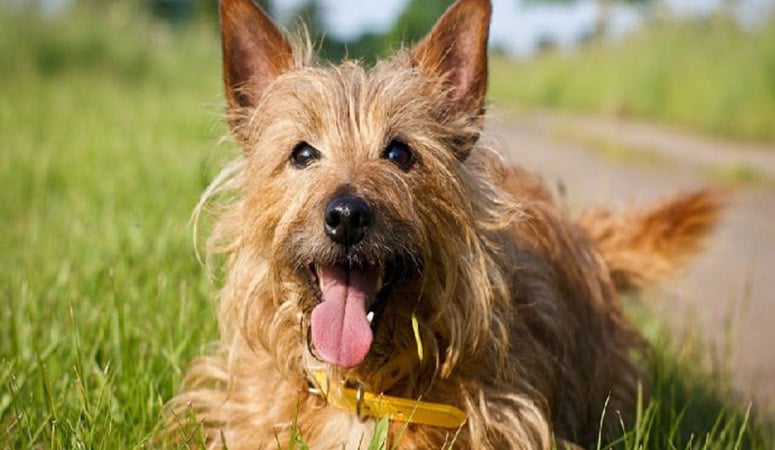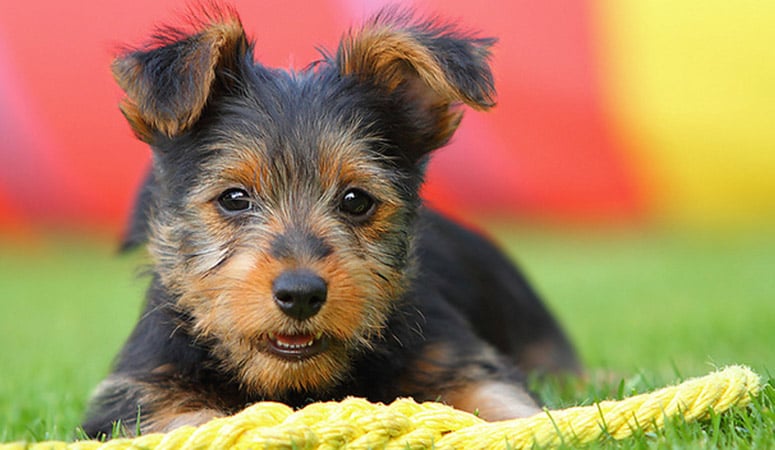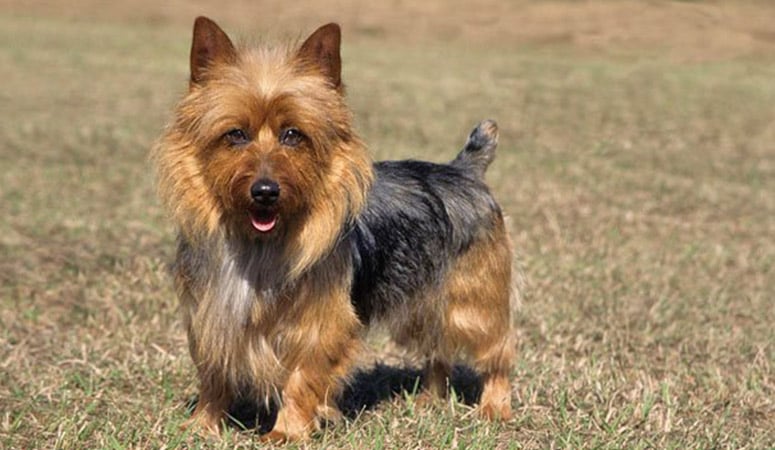Australian Terrier

The Australian Terrier is a working terrier that exhibits a ground-covering gait and hard condition with small, sturdy, and medium boned. As strong competitors in Earthdog trials, they will chase every squirrel or bird who crosses their path. With intelligence, this breed learn quickly and they are alert watchdogs. Besides Aussies are more willingly to please than most terriers.
| Other Names | Australian Rough Coat Terrier, Aussie |
| Color | Blue & Tan, Red, Sandy |
| Height | Males: 9-11 inches. Females: 9-11 inches. |
| Weight | Males: 8-15 pounds. Females: 8-15 pounds. |
| Life Span | 11-15 years |
| Personality | Affectionate, Courageous, Spirited |
| Exercise | Needs Lots of Activity |
| Origin |
| Popularity | #142 |
| Groom Needs | Weekly Brushing |
| Kids Friendly | Yes |
| Dog Friendly | Yes with supervision |
| Watch Dog | |
| Family Dog | |
| Litter Size | 3-6 puppies |
Australian Terrier Pictures
Australian Terrier Video
Introduction
This foxlike little dog, the Australian terrier, is Australia’s first native dog breed; he loves children and is highly affectionate. He stands only about 11 inches at the shoulders and weighs about 20 pounds. He has a long head and short little legs with small little feet, almost like a cat, and with an erect tail. His coat is a double coat of almost coarse stiff hair on the outside with a soft and short undercoat which comes in colors like sandy and red and blue and tan; sometimes with some black markings. They are tough little dogs with a whole lot of confidence. They have above average hearing and sight and this makes them very good watchdogs, barking at anything they consider suspicious. Due to their size, they don’t make great guard dogs. Sometimes, they bark a lot – so he will need training to know when to stop. Australian terriers need a daily walk and play as well to get rid of all their energy and an enclosed garden will do him well. They are adaptable to various climates, making them an all-purpose and all-weather dog breed.
Living with Australian Terrier
There is nothing complicated about grooming an Australian Terrier. Introduce him to grooming when he is young so he learns to accept the fuss and handling of grooming graciously.
Pay extra attention to the longer hair on his head and legs to prevent tangles. A quick brushing once a week is usually enough to keep it in fine shape.
An Aussie should have a bath only when needed. Shampooing softens the harsh coat, rendering its dirt-shedding capability ineffective, and too much bathing can also make the Aussie’s skin dry and flaky.
Check the ears once a week for dirt, redness, or a bad odor that can indicate an infection, then wipe out weekly using a cotton ball dampened with gentle ear cleaner recommended by your veterinarian to prevent problems.
As with all breeds, the Aussie’s nails should be trimmed regularly, as overly long nails can cause the dog discomfort.
Regular tooth brushing with a soft toothbrush and doggie toothpaste will help keep the Australian Terrier’s teeth and gums healthy and his breath fresh.
The breed is very active and requires regular exercise to keep from becoming bored and unhappy. A healthy, adult Australian Terrier requires more than an hour of vigorous physical activity every day. This can be a combination of long walks, hikes, dog sports training, Earthdog training, or even fetch in the living room.
Aussies want to live indoors with their pack and will develop problem behaviors if you leave them outside for too long. Keep your Aussie busy and challenged with indoor games of fetch, hide and seek, and puzzle dog toys so they don’t become bored.
Australian Terriers should spend a good deal of time outdoors participating in dog sports, or simply running around the backyard playing games of fetch. However, Aussies shouldn’t be outside alone or they’ll dig an escape route under the fence in short order.
But these sessions must take place is a securely fenced yard, and when on walks or hikes, an Aussie must be on a leash. Aussies should never run loose with strong instinct to hunt and they might not be able to resist running off to chase a cat or squirrel, and even might pursue their prey so far from home that they can’t find their way back.
Australian Terriers require approximately 0.5 to 1 cup of good quality dry dog food every day, given in two meals. The quantity can vary significantly based on your dog’s age, size, metabolism and activity level.
The quality of dog food you buy also makes a difference — the better the dog food, the further it will go toward nourishing your dog and the less of it you’ll need to shake into your dog’s bowl. Talk with your veterinarian about the optimal diet and quantity of food for your Aussie.
Some dogs are prone to getting overweight, so watch your dog’s calorie consumption and weight level. Treats can be an important aid in training, but giving too many can cause obesity.
Clean, fresh water should be available at all times.
Learn about which human foods are safe for dogs, and which are not. Check with your vet if you have any concerns about your dog’s weight or diet.
In general, the Aussie is a sturdy breed with few health problems. But just all breeds, they can suffer from some health conditions, such as luxating patella (a misalignment of the leg bones), legg-calve-perthes disease, diabetes and allergies.
Some dogs can develop itchy skin conditions, and flea control is essential. As with all breeds, the Aussie’s ears should be checked regularly for signs of infection, and the teeth should be brushed often, using a toothpaste designed for dogs.
Not all Aussies will get any or all of these diseases, but it’s important to be aware of them if you’re considering this breed. There are several health tests considerations specific to the breed, such as thyroid evaluation, ophthalmologist evaluation and patella evaluation.
Responsible breeders test all breeding stock for conditions that can affect the breed. Regular visits to the vet for checkups and parasite control help to ensure the dog a long, healthy life.
Total Annual Cost: $2674
Cost is estimated for the first year and may vary depending on many factors, such as dog food, health care, leash, collar, licensing, possible fencing, crates, training and obedience classes, dog-walking, grooming, treats, toys, flea, tick, and heart-worm meds, microchips, etc.
Since all dogs in the Terrier group tend to be bossy and aggressive around other dogs, proper socialization of your Aussie puppy is a must.
Advanced training is a smart way to keep Aussies active and mentally stimulated. They are excellent pupils in advanced obedience training, agility trials, and most other dog sports.
Australian Terriers are adept at Earthdog trials, a dog sport in which they track rodents placed within cages in underground dens.
Aussies, like many terriers, benefit greatly from puppy training classes and introductory obedience with treats, toys, or praise. Even with training, though, an Aussie can be reluctant to share toys or human attention, and two males may not be able to share a household.
They are also willful and stubborn, so a firm, consistent approach is necessary. Aussies are easily bored with routine, so training sessions should be short, whether the owner wants them to be or not.
Begin crate training when he’s a puppy, which can help you housetrain him, and it provides him with a welcome refuge as well as a familiar means of safe travel when he’s in the car.
History
The Australian terrier originates from Australia. A lot of the development of this litter terrier has not been recorded, so a lot of their history is lost.
It is not clear when the first terrier arrived on Australian soil, but it seems likely it was either the late 1700s or the early 1800s. It wasn’t uncommon for British ships to have terriers on to eliminate rats, and they might have come to Australia in this manner.
From around 1820, Australian breeders began breeding programs to develop a dog that would be suited to the Australian environment. By around the 1860s, Australian breeders had developed a terrier which was quite a bit different from any breed from the UK; the Australian terriers were smaller, long-bodied, were black and tan in color, and were short-legged. There is a lot of debate as to which terrier breeds did contribute to the development of the Australian terrier.
As the years went by, the Yorkshire terriers which arrived in Australia were mixed with the Australian terrier. Many of the offspring possessed the silky hair of the Yorkshire terrier and became known as Sydney Silkies. It is thought that the temperament of the Australian terrier was softened a lot by many years of interbreeding with Yorkshire Terriers and Sydney Silkies.
In 1887, the first Australian terrier breed club was founded in Australia, and in 1957 the Australian Terrier Club of America (ATCA) was founded.
By 1960, the American Kennel Club (AKC) registered the dog.
Helpful Information
Breed Club: AUSTRALIAN TERRIER CLUB OF AMERICA, INC.
Breed Club Link: http://www.australianterrier.org/
Breed Club Rescue: Australian Terrier Rescue
Breed Club Rescue Link: http://www.australianterrierrescue.org/




